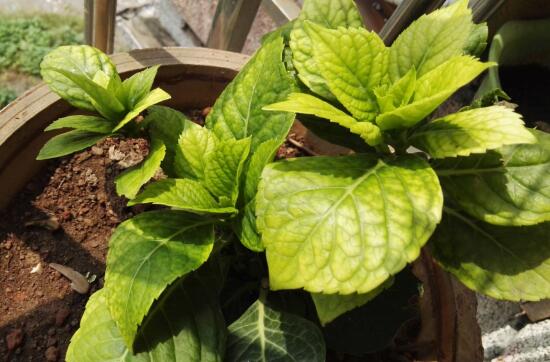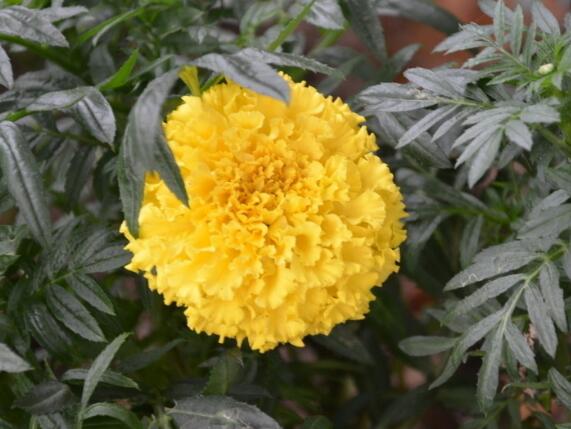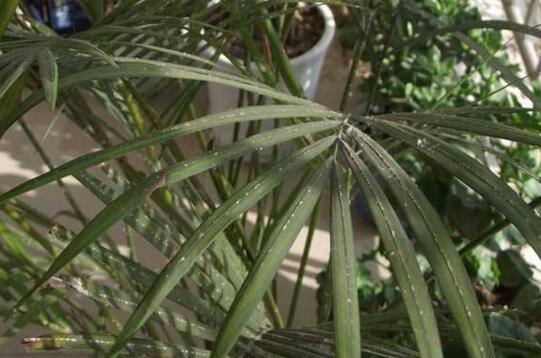What to do if the leaves of hydrangea turn yellow, control watering, fertilize properly / adjust the acidity and basicity of the soil
Hydrangea, a very beautiful flower, it is rich in color, many flower friends potted at home. However, many novices in the process of raising hydrangea, will encounter hydrangea leaves yellow situation, thus greatly reducing the ornamental value of hydrangea, then what to do at this time? In this regard, Xiaobian summarized the reasons for the yellowing of 6 kinds of hydrangea leaves. Please come in and have a look if you have problems!
How about yellow leaves, find out why?

In life, there are many people who raise hydrangea, but there may be more novices. Many of them do not raise hydrangea according to the breeding method, so hydrangea leaves often turn yellow. As for how to do hydrangea leaves yellowing, Xiaobian summed up 6 points, and attached solutions, we then look down.
Second, hydrangea leaves yellow reasons and solutions
1. Environmental mutation
There are many reasons for hydrangea leaves yellowing, but we should first consider environmental factors. In life, many flower friends hydrangea are bought online, which easily leads to large geographical span, so that hydrangea temporarily can not adapt, resulting in yellow leaf symptoms.
Solution: At this time, everyone can communicate with the store to understand the growth environment before hydrangea is bought, and then everyone creates the same environment at home. Then we can slowly change until the plant is fully adapted to the current environment, and after a while, the hydrangea will return to health.
2. Alkaline soil
In hydrangea breeding methods, we have said that hydrangea suitable for growth in slightly acidic soil. If we put hydrangea culture alkaline soil, a long time, hydrangea leaves will yellow situation.
Solution: If it is caused by alkaline soil, quickly change the basin soil, replace it with loose and fertile slightly acidic soil, and carefully maintain it for a period of time to recover.
3, too strong or insufficient light
Hydrangea likes shade and does not like yang, so the light must not be too much, once the light is too strong, hydrangea leaves will be yellow and white, there are brown spots appear; hydrangea can not be less light, once the light is insufficient, the plant will appear slender excessive growth, leaf color yellow symptoms.
Solution: The light is too strong, it should be moved to a cool and ventilated place, prevent direct sunlight, and pour appropriate water, and carefully maintain for a period of time; insufficient light, very simple, increase the light time, slowly restore.
4. Too much watering (yellow water)
Hydrangea like wet environment, but once too much watering, resulting in basin water, resulting in poor soil permeability, hydrangea part of the fibrous roots will rot, showing symptoms are: hydrangea tender leaves dark yellow dull, new shoots atrophy.
Solution: At this time we should suspend watering, and give hydrangea loose soil to dry, to be dry and then watering. If it is known after the rain, the water in the basin should be poured out in time, and then carefully maintained for a period of time to recover.
5. Long-term water shortage (drought yellow)
In addition to too much watering, long-term lack or too little watering, resulting in too dry pot soil, will also cause hydrangea leaves yellow. The symptoms are as follows: although the new leaves are normal in color, the lower leaves gradually dry and yellow and fall off aging.
Solution: At this time, we should first pour a small amount of water, after half an hour to pour water, while spraying water to the branches and leaves.
6. Excessive fertilization or long-term lack of fertilizer
Hydrangea like fertilizer, but fertilizer can not be too much, once more, it is easy to cause burning roots, so that the leaves of the plant brown fall off; fertilizer can not be less, once there is no long-term soil change fertilizer, especially lack of nitrogen fertilizer, hydrangea will be due to insufficient nutrient supply, and the symptoms of yellow leaves.
Solution: excessive fertilization, should suspend fertilization, and increase the amount of watering, so that fertilizer from the bottom of the basin drain hole flow out, or see the point, directly change the pot soil; lack of fertilizer, change the pot soil, replace the new nitrogen-containing fertile loose soil, and every 10 days or so pouring a thin liquid fertilizer or compound fertilizer, soon after, hydrangea leaves will be yellow green.
What if the hydrangea leaves are yellow and wilted?
Hydrangea flower's main value lies in the view flower, the flower big color beautiful ornament room, beautiful. However, in the maintenance of the phenomenon of yellowing leaves often appear, the next introduction of hydrangea leaves yellowing how to do, for different yellowing causes one by one to solve.
How to do hydrangea leaves yellowing (cause analysis and solution) 1, hydrangea leaves yellowing: acidic soil
Hydrangea is suitable for growing in acidic soil because it contains a lot of iron, which can meet its nutrient needs. If the planting soil is alkaline or long-term alkaline, neutral water, will lead to iron deficiency in the soil, leaf color will gradually turn yellow. The main performance is the top of the young leaves yellow, yellow old leaves, but the veins are still green, with the disease aggravated, the whole plant leaves will turn yellow, leaf edge withered coke, and gradually wither.
solution
10-20 Pouring ferrous sulfate solution or potassium dihydrogen phosphate solution once a day to ensure that the soil is acidic. Or directly pour 150-250 times of edible rice vinegar diluent, 3-4 times can be effective. (These three solutions are best used in turn for better results) When planting or turning pots for soil, add sulfur powder to the soil to ensure that the soil is acidic and its validity period can last for 2-3 years. Spring and autumn season luxuriant foliage, 15 days of application of alum fertilizer water, can prevent the occurrence of plant chlorosis, make leaves bright green.
2. Hydrangea leaves yellow: light
Hydrangea flowers like a semi-shady environment and grow well under scattered light conditions. Growth to avoid direct sunlight is said to be insufficient light, too strong light, leaves will be yellow white, yellow brown spots appear; if the light is insufficient, the branches are thin, the leaves are thin, and the leaves are dull.
solution
Light too little, to increase the lighting time appropriately, slowly can be restored. If the light is too strong, the plant should be moved to a cool and shaded place immediately to avoid direct sunlight. At the same time, water is often sprayed to the leaves and the surrounding environment to increase the air humidity, and gradually the leaves gradually return to green.
Yellow leaves: drought
Hydrangea flowers prefer a relatively wet environment and are afraid of waterlogging and drought. Too much watering, pot water and lack of oxygen, resulting in root rot, leaves yellow; too little watering, roots absorb less water, leaf tips dry yellow, plants from bottom to top gradually yellow off.
solution
Watering insist on dry watering, watering too much when stop watering, loose soil to dry. Water too little, the soil surface is too dry, you can first pour a small amount of water, half an hour later in the irrigation of water, while spraying water to the branches and leaves.
Yellow leaves of hydrangea: fertilization
Hydrangea fertilization process, fertilization too thick or raw fertilizer, easy to burn roots, resulting in yellow leaves. If the plant has not changed the soil for a long time, especially the lack of nitrogen fertilizer, the plant growth does not get enough nutrients, and the leaves lose green and yellow.
solution
When fertilizing too much, stop fertilizing immediately and irrigate a small amount of water. Or directly remove the plant from the pot, wash the plant with clean water, change the soil and replant. If too little fertilization causes yellow leaves, timely soil fertilization, about 10 days a thin liquid fertilizer, leaves will gradually turn green.
What if the hydrangea wilts?
After hydrangea wilted, many people thought it would wither immediately and could only give up. In fact, embroidery is not so fragile, as long as timely remedy, or can open beautiful flowers.
1, flowerpot watering must be watered thoroughly, hydrangea like wet soil, but also to flowers and leaves watering. But don't spray too much water or it will backfire.
2, hydrangea afraid of the sun, so do not take out the flowers when the sun is very abundant, if the flowers wilted can be in a cool place for a few days.
3. Regularly fertilize hydrangea flowers to ensure the necessary nutrients.
Hydrangea is suitable for growing in wet, fertile and acidic places, and dry places in winter are better.
The temperature is kept at about 18-28 degrees, not lower than 5 degrees in winter, and about 16 degrees after flowering. High temperatures can make hydrangeas fade quickly.
What about the yellow leaves of hydrangea?
Maintaining acidic soils
The reason why the leaves are yellow.
Hydrangea is suitable for growing in acidic soil because it contains a lot of iron, which can meet its nutrient needs. If the planting soil is alkaline or long-term alkaline, neutral water, will lead to iron deficiency in the soil, leaf color will gradually turn yellow. The main performance is the top of the young leaves yellow, yellow old leaves, but the veins are still green, with the disease aggravated, the whole plant leaves will turn yellow, leaf edge withered coke, and gradually wither.
solution
Ferrous sulfate solution or potassium dihydrogen phosphate solution is poured once every 10 to 20 days to ensure that the soil is acidic. Or directly pour 150~250 times of edible rice vinegar diluent, 3~4 times can be effective. (These three solutions are best used alternately.)
When planting or changing soil, sulfur powder is added to the soil to ensure that the soil is acidic and its validity period can last for 2~3 years.
Spring and autumn season luxuriant foliage, 15 days of application of alum fertilizer water, can prevent the occurrence of plant chlorosis, make leaves bright green.
reasonable lighting
The reason why the leaves are yellow.
Hydrangea loves a semi-shady environment and grows well under scattered light conditions. Growth to avoid direct sunlight is said to be insufficient light, too strong light, leaves will be yellow white, yellow brown spots appear; if the light is insufficient, the branches are thin, the leaves are thin, and the leaves are dull.
solution
Light too little, to increase the lighting time appropriately, slowly can be restored.
If the light is too strong, the plant should be moved to a cool and shaded place immediately to avoid direct sunlight. At the same time, water is often sprayed to the leaves and the surrounding environment to increase the air humidity, and gradually the leaves gradually return to green.
drought is appropriate
The reason why the leaves are yellow.
Hydrangea likes a relatively wet environment and is afraid of waterlogging and drought. Too much watering, pot water and lack of oxygen, resulting in root rot, leaves yellow; too little watering, roots absorb less water, leaf tips dry yellow, plants from bottom to top gradually yellow off.
solution
Watering insist on dry watering, watering too much when stop watering, loose soil to dry.
Water too little, the soil surface is too dry, you can first pour a small amount of water, half an hour later in the irrigation of water, while spraying water to the branches and leaves.
Apply fertilizer correctly
The reason why the leaves are yellow.
In the process of applying fertilizer, too much fertilizer or raw fertilizer can easily burn roots, resulting in yellow leaves. If the plant has not changed the soil for a long time, especially the lack of nitrogen fertilizer, the plant growth does not get enough nutrients, and the leaves lose green and yellow.
solution
When fertilizing too much, stop fertilizing immediately and irrigate a small amount of water. Or directly remove the plant from the pot, wash the plant with clean water, change the soil and replant.
If too little fertilization causes yellow leaves, timely soil fertilization, 10 days or so a thin liquid fertilizer irrigation, leaves will gradually turn green.
- Prev

How to fertilize marigold, matters needing attention in fertilization / dilution before fertilization
Among the efficacy and function of marigold, its ornamental value is the most familiar to people, but if we want it to be ornamental, the maintenance process must be careful, among which fertilization is the most important. Fertilizer is the main nutrient in the growth process of marigold. Sufficient fertilizer is needed to make marigold blossom.
- Next

What about the yellowing of the leaves of Phyllostachys pubescens? we need to understand 12 main reasons and solutions.
Although the fengshui function of Phyllostachys pubescens is many, in order to play its role of thriving and attracting wealth, it is necessary to have tall plants and green leaves. If the leaves are yellowing is obviously not good, then what should we do if the leaves turn yellow? This is what every flower friend should know.
Related
- Fuxing push coffee new agricultural production and marketing class: lack of small-scale processing plants
- Jujube rice field leisure farm deep ploughing Yilan for five years to create a space for organic food and play
- Nongyu Farm-A trial of organic papaya for brave women with advanced technology
- Four points for attention in the prevention and control of diseases and insect pests of edible fungi
- How to add nutrient solution to Edible Fungi
- Is there any good way to control edible fungus mites?
- Open Inoculation Technology of Edible Fungi
- Is there any clever way to use fertilizer for edible fungus in winter?
- What agents are used to kill the pathogens of edible fungi in the mushroom shed?
- Rapid drying of Edible Fungi

